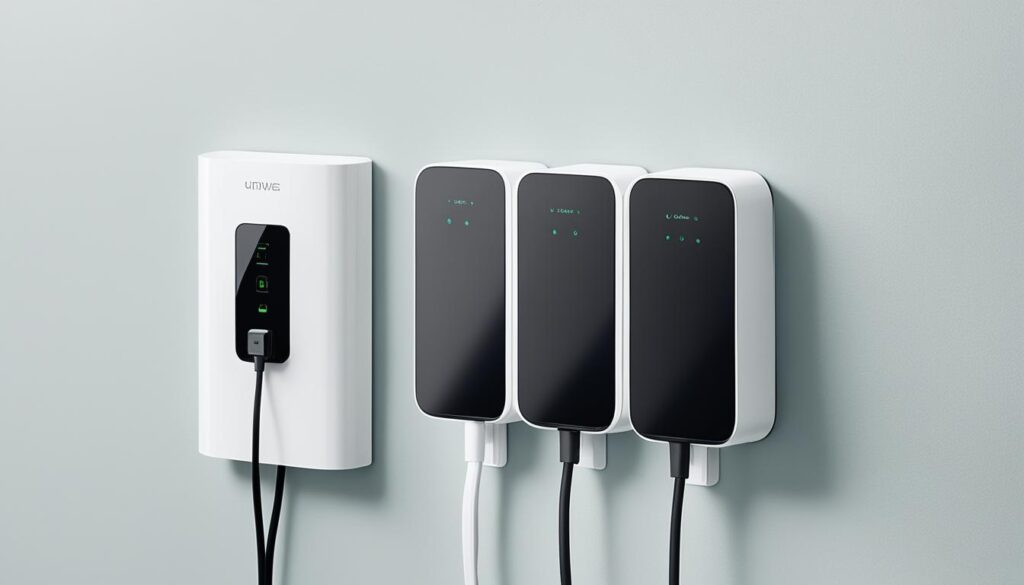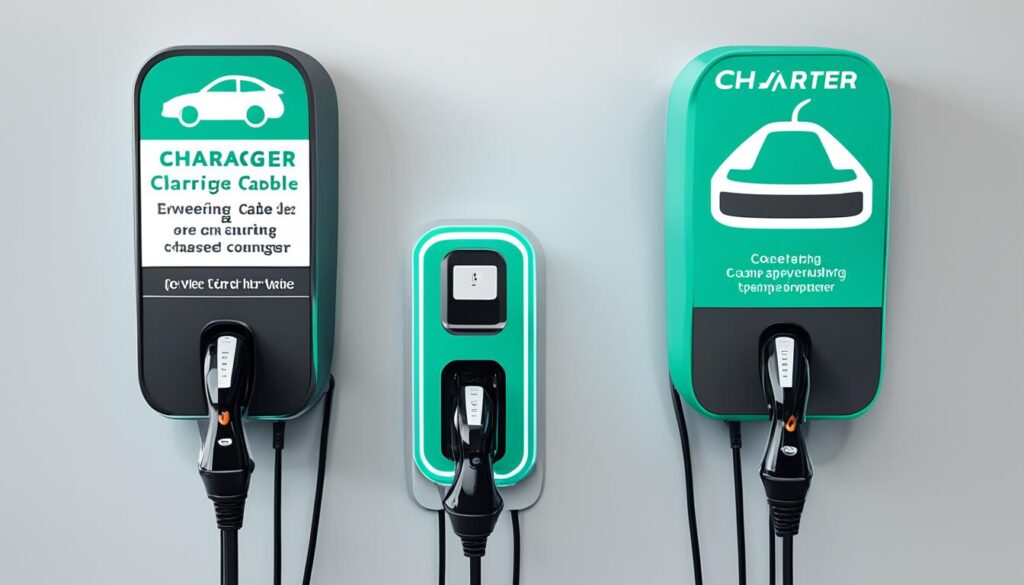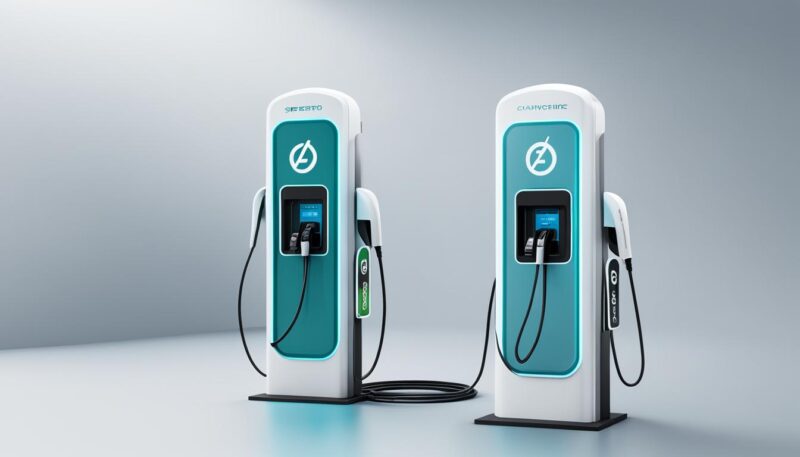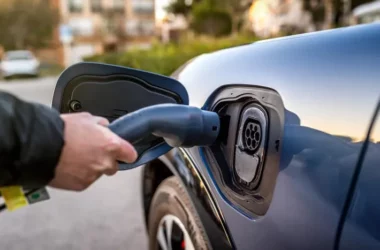Deciding on a home charger for my electric vehicle (EV) is tricky. I must choose between a tethered or untethered charger. Each has benefits for UK EV owners. Understanding both is key to choosing the best one for my car.
Key Takeaways
- Assessing whether a tethered or untethered electric vehicle charger suits your lifestyle and parking arrangement is essential.
- The choice between tethered and untethered can impact the ease of use and flexibility when charging your EV at home.
- It’s important to consider future-proofing your charging infrastructure by selecting a charger that will accommodate potential new EV models.
- A tethered charger comes with a fixed cable, which can be either a boon or a bane, depending on your specific circumstances.
- An untethered charger might offer better compatibility with various vehicles, making it a versatile option for households with multiple EVs.
- Investing in the right type of EV charger, be it tethered or untethered, could enhance the overall electric vehicle ownership experience.
Understanding Tethered and Untethered Chargers
Choosing an EV charger is very important. It can change how easy and fast you charge your car. Knowing the difference between a tethered and an untethered charger helps you choose better.
Defining Tethered EV Chargers
A tethered charger has a cable that doesn’t come off. It’s always ready to use. This is great for home use. It lets you connect your car quickly without looking for a cable.
The Mechanics of Untethered Chargers
An untethered charger has no fixed cable. You can use different cables for different cars. It’s good for people with more than one car or who might get a new car later.
Key Differences That Influence Your Choice
Tethered chargers are very convenient. You won’t forget your cable. But, they might not fit a new car if it needs a different cable.
Untethered chargers let you change cables. You need to buy and look after the cable. This choice is good if you plan to change cars in the future.
If you have one car and like things easy, get a tethered charger. If you have many cars or might change your car, an untethered charger is better. It gives you more freedom to change.
Assessing the Pros and Cons of Each Charger Type
I need to think about tethered and untethered chargers for my home EV charger. This will help me pick the best one for my lifestyle and EV needs.

Tethered charger advantages mean I don’t have to worry about the cable. It’s always attached, making it easy to use. Untethered charger advantages let me use different cables. This is great for different EVs or future updates.
Tethered charger disadvantages include a fixed cable that might be too short. It can be a problem for EVs with charge ports on other sides. Untethered charger disadvantages mean I have to keep track of the cable. There’s also a chance I might forget it.
| Tethered Charger | Untethered Charger |
|---|---|
| Convenience of fixed cable | Flexibility to use different cables |
| No need for cable storage | Manageable cable storage solutions needed |
| Limited by cable length | Customisable cable length options |
| Potential charging port compatibility issues | Universal compatibility with replaceable cables |
Choosing depends on how you use it. If you park in the same place and your EV fits the cable, tethered is handy. If you like flexibility or have different EVs, go for untethered.
Thinking ahead is key for me. Tech keeps changing, so untethered’s cable swapping is good for the future. But tethered’s easy daily use is still tempting.
The Impact of Tethered or Untethered Charger on Charging Infrastructure
Choosing a tethered or untethered charger affects the charging setup and installations. It helps plan for the electricity needs of electric cars. This planning makes charging easy and future-ready. The type of charger and how it’s installed matters a lot. It affects how easy and convenient charging is for the user.

Installation Requirements and Charging Infrastructure
Tethered and untethered chargers are different to install. Tethered chargers have a fixed cable. This might limit where you can put them. Untethered chargers are more flexible. But, you must buy a separate cable that fits your car.
When setting up charging spots, think about the charger’s power. And if it’s good for homes or businesses. Putting chargers in the right spot makes it easier for everyone to use them. It helps more people switch to electric cars.
Compatibility with Electric Vehicle Models
Choosing an EV charger means thinking about if it fits your car. Different cars need different charging ports. Tethered chargers must fit your car’s port. Untethered chargers use different cables. You need the right one.
Thinking about the future can make untethered chargers seem better. They fit different cars easier. Also, think about if other people’s cars can use your charger. This is good if you have guests or customers.
Electric Vehicle Charger Connection Types: Type 1 and Type 2
In the UK, Type 2 chargers are common. They are the main type in Europe for AC charging. Type 1 is less common in the UK. It’s mostly in older EVs from Asian makers. Know which type your car needs before you get a charger.
| Connector Type | AC/DC Charging | Max Charge Rate | Common Regions | Compatibility |
|---|---|---|---|---|
| Type 1 | AC | Up to 7.4 kW | Asia, some American models | Primarily older EV models |
| Type 2 | AC/DC | Up to 22 kW (AC), up to 350 kW (DC Fast Charging) | Europe, including UK | Current and future European models |
Type 1 and Type 2 are important for choosing chargers. Tethered chargers must match the car’s port. Untethered chargers work with adapters or different cables. This means they can fit more car models.
It’s important to research well or get professional advice. This helps you choose a charging system that fits your life and your car.
Conclusion
We’ve looked at different EV charger options. Now, let’s decide between tethered or untethered chargers. People with estate cars or those who drive in cities need to think about what they need. A tethered charger means you don’t have to bring a cable with you. But an untethered charger can fit many types of cars.
Choosing the right charger means thinking about what’s handy and what works well with your car. You need to pick a charger that fits your car and where you’ll charge it. It’s important to think about the different plugs and what your car needs.
The choice isn’t just for now, but for the future too. We need to be ready for new types of cars. Choosing the right charger means thinking about the long term. I hope this makes it easier for you to choose the best EV charger. One that suits your life and supports green cars.











In addition, the Terminal deoxynucleotidyltransferase TdT assay was also used priligy medicine